Did you know that Insects make up more than half of all known living organisms on Earth! There are more than a million different species worldwide and they all play a vital role in our environment by pollinating plants, breaking down organic waste matter, recycling nutrients back into the soil. providing a vital source of food for other wildlife as well as controlling pest populations.

Not all minibeasts you will find are actually insects. Slugs and snails for example are classed as gastropods, millipedes and centipedes are myriapods, woodlice are crustaceans and spiders, mites, ticks and scorpions are arachnids.
Insects are animals defined as having 6 legs, a three part body (consisting of a head, thorax and abdomen), compound eyes, antennae and a hard exoskeleton. Some insects can fly like bees, butterflies and beetles, others are ground dwelling like ants, and some can jump and climb like grasshoppers and crickets.

Insects need a hard exoskeleton to protect them and support their bodies as they are invertebrates which means they don’t have a backbone. Most minibeast are invertebrates and It is estimated that an amazing 97% of all the animals species on the planet are invertebrates!
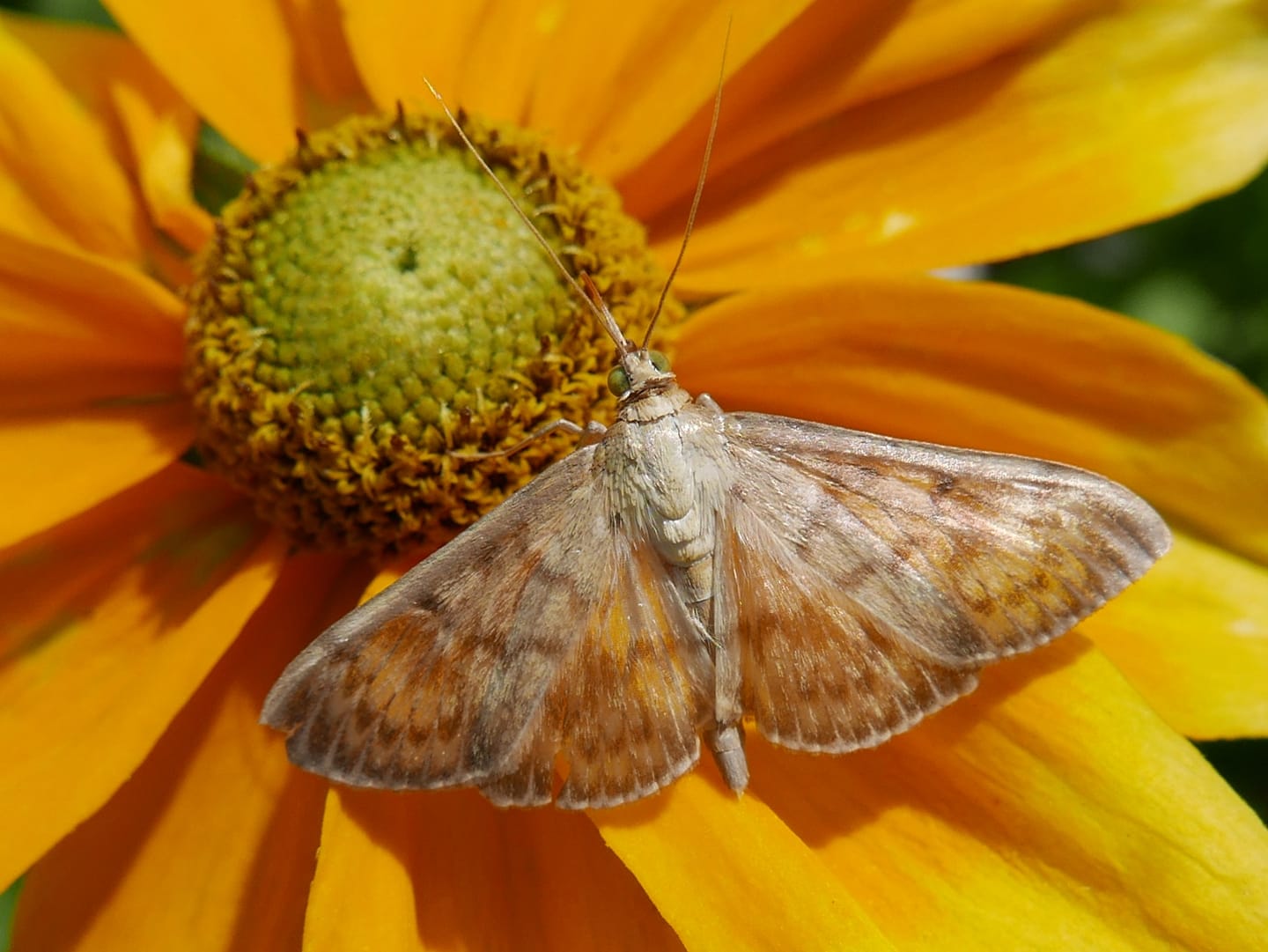
You can find a handy guide to finding insects and minibeasts below as well 100+ easy educational activity ideas to help you explore and learn more about these amazing creatures. As there are so many activity ideas I have divided them into 16 easy to read sections with separate links to the specific species activity and information pages.
1. Spot pollinators amongst the wildflowers
You will often find pollinating insects like bees, beetles, butterflies and moths in sunny spots in or around flowers. It is fascinating to watch them flit from flower to flower feeding on the nectar. You could take a notepad or camera with you to record your finds or even print out some nature bingo or scavenger hunt sheets. Can you see which types of flowers certain insects prefer? Are some more popular than others? You can find several handy guides to identifying pollinating insects below:
- The Butterfly Conservation guide to identifying butterflies and moths here
- RSPB guide to beetles here.
- Countryfile guide to beetles here.
- Bumble Bee Conservation Trust guide to identifying bees.
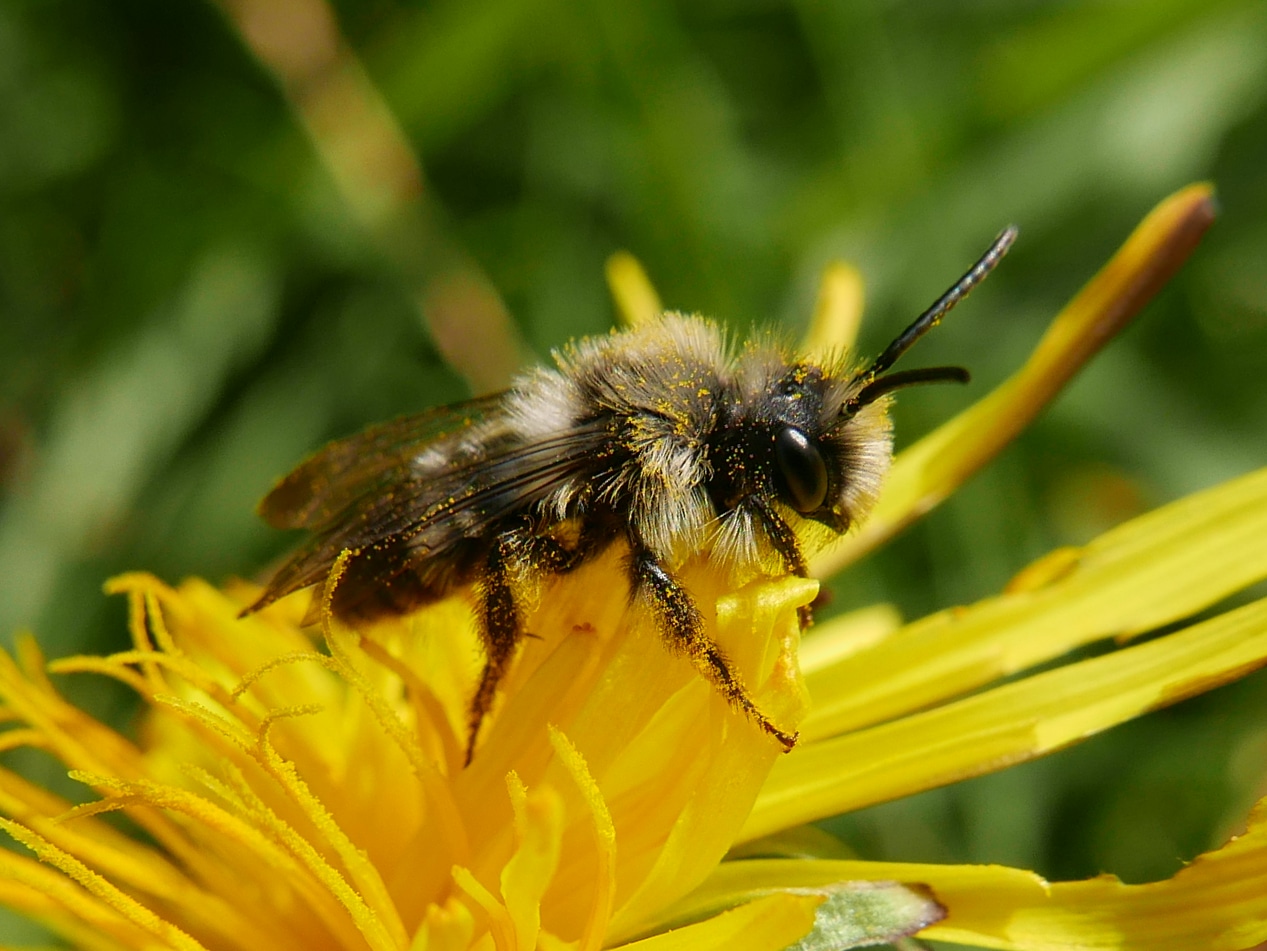
Did you know there are over 20,000 species of bee in the world, 90% of which are solitary bees! You may also be surprised to find that there are only 9 species of honey bee and 250 species of bumble bee in comparison to the thousands of species of solitary bee. All of the bee species feed on pollen and nectar which they gather from flowers. In doing so they play a vital role in pollination as they carry particles of pollen from each plant and tree to the next. They also provide a important source of food for other wildlife like birds, insects, spiders and even mammals. You can find 16 bee activity ideas and lots of bee facts here.

2. Look at the undersides of leaves
The undersides of leaves are often teeming with insects, eggs, caterpillars and larva that you would normally overlook. It’s the perfect place for them to shelter away from predators, wind and rain as well as often providing a source of food. How about looking carefully up at the leaves on low tree branches or crouching down under a bush and shrub and looking up to see what you can find. You can find a great guide to identifying caterpillars here.

A butterfly starts its life as an egg on the underside of a plant or leaf. The eggs will then hatch out into tiny caterpillars which immediately begin to consume the plant leaves, eating and growing, eating and growing. Once they have finished growing they start getting ready to transform into the pupa stage and will climb to a safe, sheltered place on a plant like the underside of a leaf, branch or stem. They attach themselves to the surface using special silk and then hang head downwards. The outer skin begins to harden as they started their transformation into chrysalis. Inside the chrysalis an amazing transformation takes place, the caterpillars use digestive enzymes to dissolve themselves and then their cells are rearranged and rebuild to form a butterfly. You can find 22 Butterfly and caterpillar activities and lots more butterfly facts and information here.

3. Shake a bush tree or shrub
Smaller harder to spot insects and fast moving spiders often live and shelter on the branches and leaves of bushes, trees and shrubs. If you carefully shake or tap tree branches you can then catch the insects that fall off in an umbrella, old sheet or washing tub placed beneath the branches.

Many of the insects will be quite tiny so look carefully for scurrying movement before they hide or escape. You can use a magnifying glass or pot to observe them more closely. Make sure you return any insects you find back to the same, tree, shrub of bush so they can return home safety. We often find tiny beetles as well as ladybirds and shield bugs in bushes and shrubs.

There are over 300,000 species of Beetles in the world, 4,000 of which can be found in the UK. Beetles are one of the largest groups of insects in the world and make up almost a quarter of all known living species (including plants) on the planet! Because of this they play a vital role in the pollination as well as providing a important source of food for other wildlife. You can find 10 Beetle activity ideas plus more fun fact here.

4. Sweep a net through long grass
Long grass is home to a multitude of minibeasts and insects. It’s a perfect place to hide with cool shade and moisture as well as plenty of food in the form of grass seed, wildflowers or even other insects. You can often find grasshoppers and crickets in summer long grass by listening out for their calls and chirps. The easiest way to catch insects in long grass is by gently sweeping a net through the grass stems. The Orthoptera & Allied Insect Society have a great guide o identifying grasshoppers and crickets here.

In shorter grass you may be able to spot termite or ants nests. Did you know there are over 12,000 species of ants in the world? They are one of the most abundant species of insects on the planet, outnumbering humans by over a million to one! Ants play a vital role in the environment, aerating soil and improving drainage by digging tunnels, removing waste, helping with decomposition, returning nutrients to the soil, dispersing seeds and controlling populations of pest insects by preying on them. The ants themselves also provide a source of food for other wildlife. You can find 12 Ant activity ideas plus lots of fun ant facts here.

5. Go on a garden safari
There are often lots of minibeast and insects that make their home in gardens. Snails and slugs are often among the easiest minibeasts to find and observe in gardens. You can normally find them hiding in shady spots, under leaves, on plant pots or along borders.
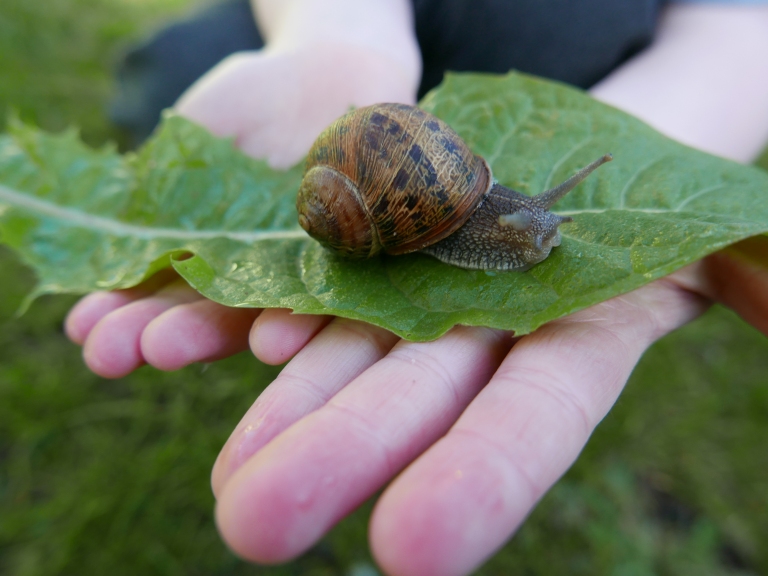
Land snails are surprisingly remarkable creatures, for example did you know that they have over 14,000 teeth, can lay up to 120 eggs and have the ability to hibernate to survive during dry spells and colder months? Snails hibernate by sealing the entrance of their shell with a dry layer of mucus (called an epiphragm) to seal the moisture in. They normally only hibernate for a few weeks or months but can also survive hibernating for several years. You can find 10 Land snail science and craft activities here.

Slugs are also remarkable creatures, did you know that slugs play a vital role in our environment and ecosystems? They feed on decaying organic matter which helps with decomposition and releases nutrients back into the soil as food for plants. They also provide an important source of food for an extraordinary array of wildlife, from mammals such as hedgehogs, foxes and badgers to birds, reptiles, amphibians, insects and even some types of fish. You can find 10 slug activity ideas and lots more information here.

6. Turn over logs and stones
Many insects like beetles and minibeasts like woodlice, centipedes, millipedes slugs and snails like to hide in moist, dark shady places under stones and logs. Rotting wood in particular provides a source of food and an egg laying place for some species.

Woodlice are amazing little recyclers that play a vital role in our environment and eco systems. They break down dead and decaying organic matter releasing the nutrients back into the soil as food for plants. They also provide an important source of food for wildlife like birds, toads, shrews, ground beetles and spiders. You might be surprised to find that woodlice are part of the crustacean family and are therefore more closely related to shrimps and crabs than they are insects. Like all crustaceans woodlice have blue blood that contains a copper based molecule called hemocyanin. They also breath through gills which need to be covered in a thin layer of water to work. This is why woodlice are mostly nocturnal and prefer to shelter in moist and damp places out of direct sunlight. You can find 10 Woodlice activity ideas and more fun facts and information here.

You can find photo guides to identifying and recording centipedes and millipedes on the Nature Spot website here. Millipedes like to curl up into spirals to defend themselves from predators. A millipede is only born with 3 sets of legs but they can grow between 100-200 more in their lifetime. They are thought to have been one of the first invertebrates to walk on land, and fossilized millipede remains have been found from nearly 420 million years ago.
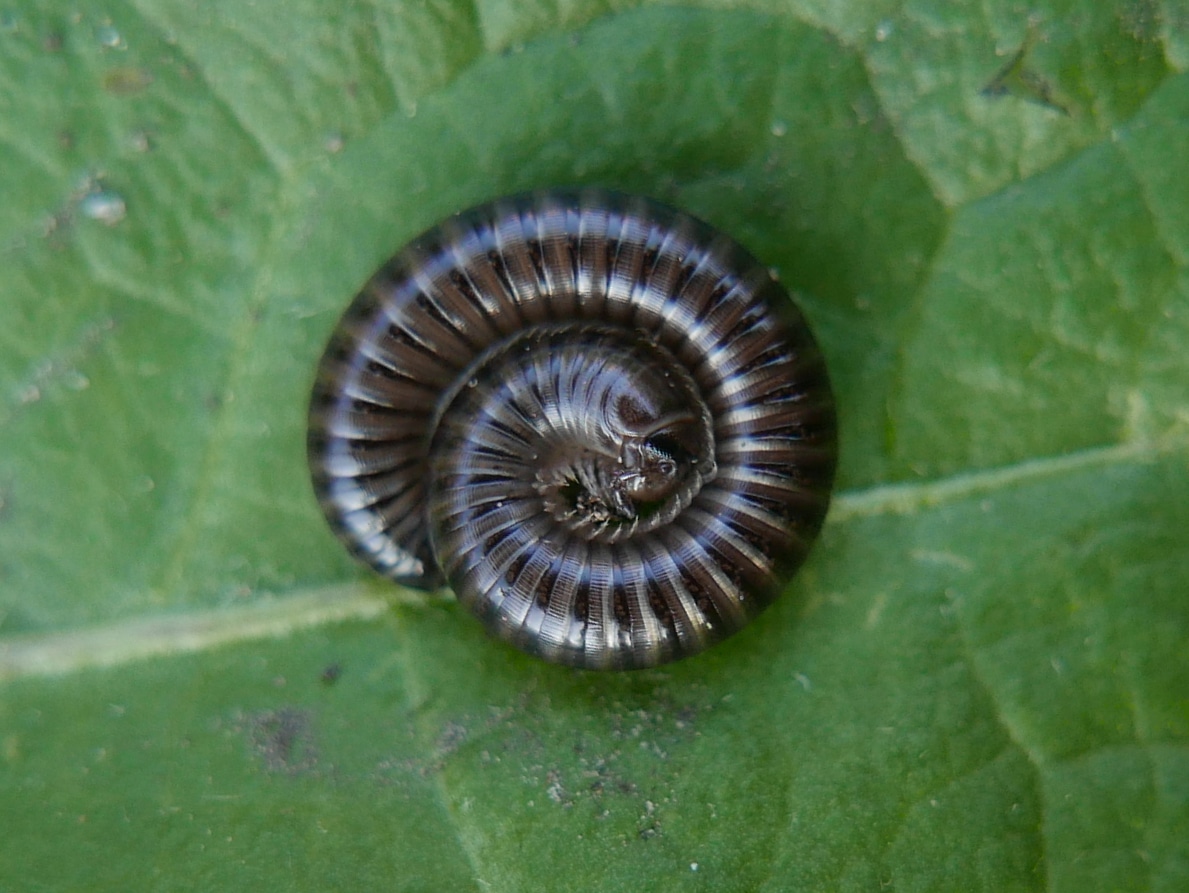
Centipedes are ferocious hunters: they like to prey on other invertebrates. You will often find them under rocks, logs and bark. They are often very speedy and scurry off to hide as soon as they are spotted.

You may even find the occasional amphibian like frogs and toads or reptiles like slow worms. Slow worms are a protected species in the UK, they are legless lizards that eat invertebrates like slugs. The Amphibian and Reptile Conservation have photo guides to identifying amphibians and reptiles here
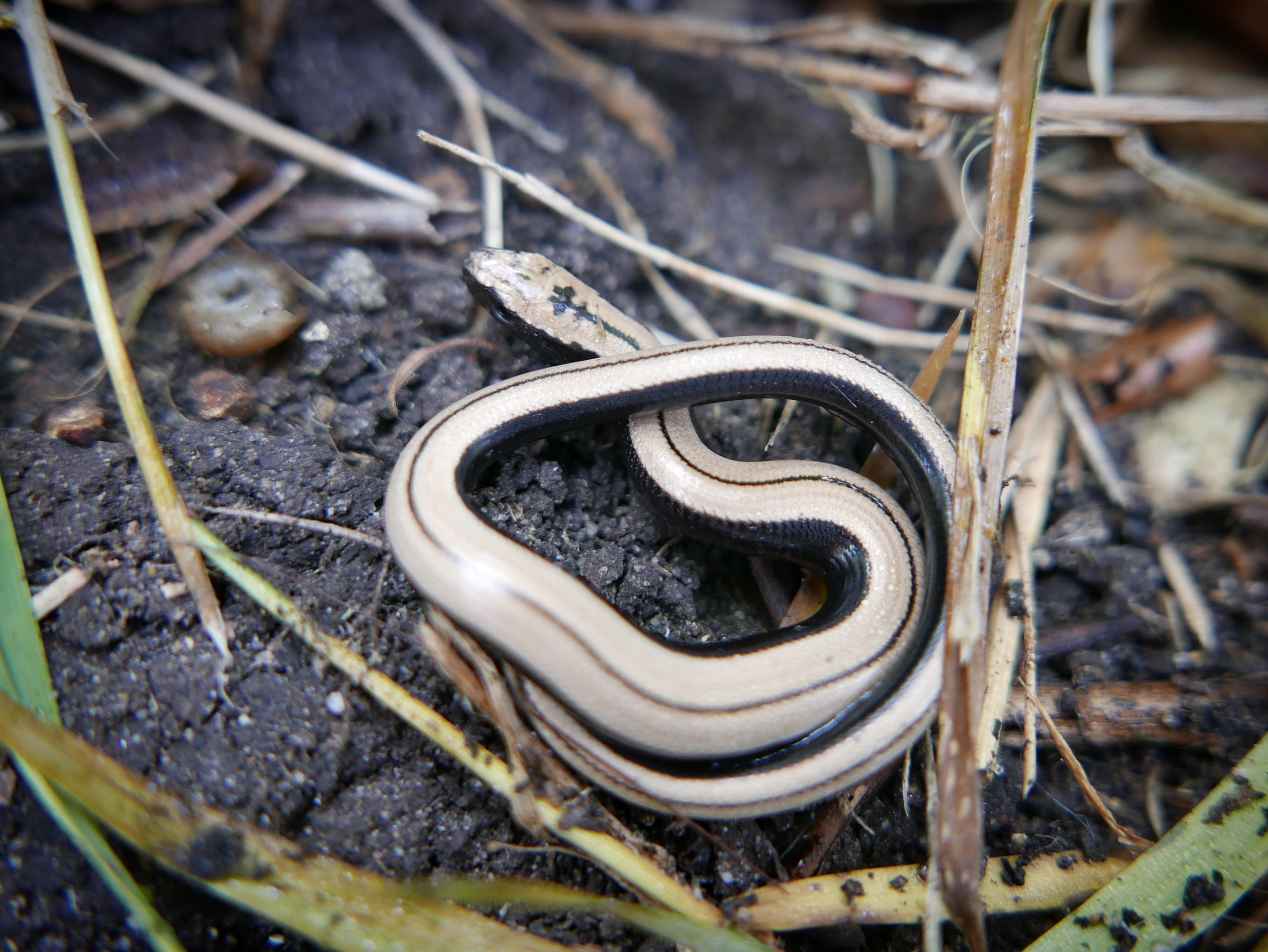
7. Make a tumble trap
A tumble trap is a simple but effective way to catch and observe ground dwelling spiders and insects. All you need for a tumble trap is an old pot, (recycled yogurt pots work perfectly for this) and something to dig a hole with.

You simply dig a hole in a shady or sheltered area big enough to fit the yogurt pot into to create your a tumble trap. The idea is insects will tumble into the pot and be unable to climb out. Please make sure you check the pots regularly and carefully release any insects you have caught after observing them. Never leave the pots out when its wet or raining as insects can be put in danger of drowning.

Did you know that there are over 40,000 species of spider in the world. They play an important role in controlling pest insect populations, provide a vital source of food for other animals and have the incredible ability to produce silk. Although almost all spiders produce silk only 50% of spider species use it to build webs, the rest use it for building egg sacs, wrapping up prey, flying on the wind, climbing, abseiling or even in the case of water spiders using it to hold an underwater air supply. You can find a great photo to UK spiders here to help you identify any you might find. You can also help citizen science by recording any spider finding on the British Arachnological Society’s spider recording record site here. Or you can enjoy 9 Spider activities and more fun facts here.

8. Go pond dipping
Pond dipping is a fun way to find and observe aquatic minibeasts and insects, despite the name you can pond dip in any body of water as long as it’s safe to do so. Please be aware of the health and safety risks or restrictions in any area you visit.
All you need for pond dipping is a net and a container to hold water in. Welly boots and waterproofs might also be a good idea your child is likely to splash about in the water. An magnifying glass can also be fun but isn’t essential.

Simply fill your container with water directly from the area you are dipping in. Then carefully swirl your net through the water or gently on the bottom of the water to catch some aquatic wildlife. Carefully turn your net upside down on the surface of the water in your container so any creatures caught in the net are transferred safely into the container.
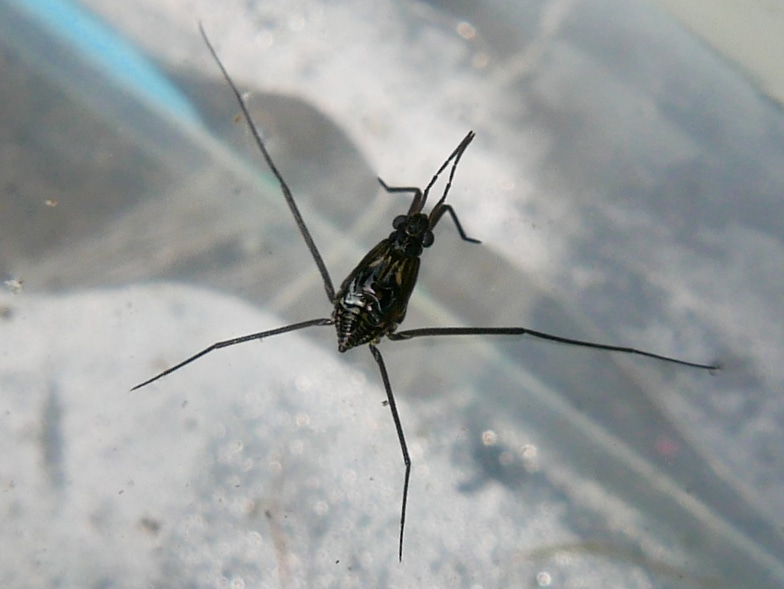
Next watch the water carefully for signs of movement. Many of the creatures you will catch will be small and some are even translucent so they can sometimes be easy to miss at first glance. There are lots of free photo guides you can download to help you identify any water insects or wildlife you might find. The RSPB have a fantastic pond mini beast guide that you can download here.
9. Conduct a soil survey to find minibeasts
To conduct a soil survey first mark out a 30cm by 30cm square area. Then dig down to a depth of 5cm and remove all the soil onto a container. Then carefully sieve thorough the soil on a tray to see what insects and minibeast you can find. Can you spot any larva? How many worms can you find? You can measure the worms to see how long and use the Imperial College of London’s guide to identifying earthworms here.
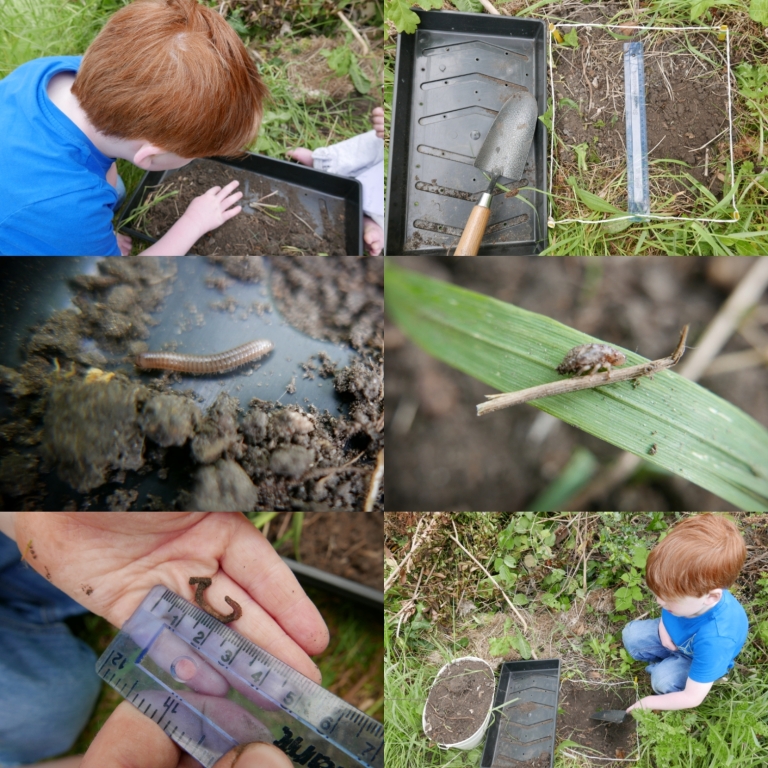
Earthworms play a vital role in our environment and eco system? They decompose organic matter by feeding on it and recycling the nutrients back into the soil as food for plants. Worm poo (or castings) can contain up to 5 times more nitrogen, 7 times more phosphorus, and 1000 times more beneficial bacteria than regular soil. As they move and burrow through the earth the worms also help to loosen, mix and aerate the soil around them. This improves the structure of the soil allowing water to drain through more easily and circulating oxygen through the soil which is vital for soil microorganisms as well as plants. You can find lots of earthworm and soil activity ideas here.

10. Explore insects and minibeasts at night
Just as the rest of the world is going to bed the creatures of the night begin to emerge. This is a wonderful time to observe and discover the hidden world of nocturnal insects and minibeasts you normally never see. All you need is a torch, warm sensible clothing and a safe space to explore. We also like to have hot chocolate and a blanket with us to warm up with if it gets too chilly.
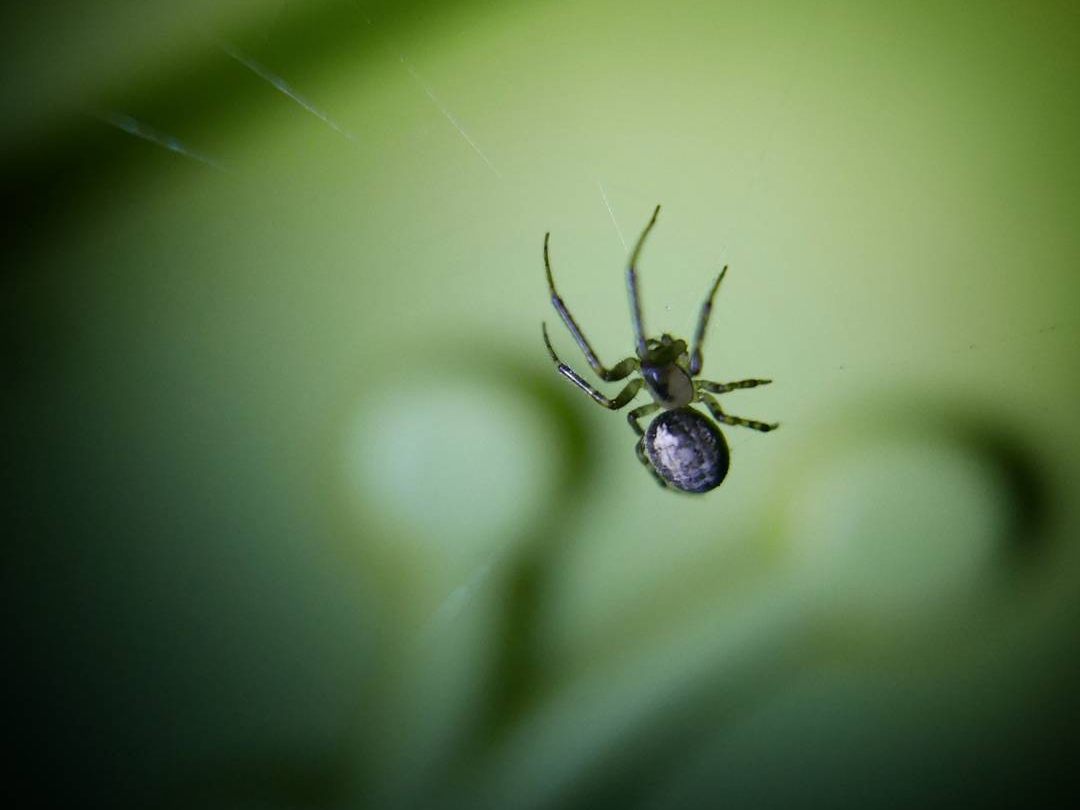
Some spiders are naturally more active at night when there are less predators and but more prey in the form of nocturnal flying insects. You can often use a torch to pick out the reflective silk threads of the webs and find the spiders sitting in the middle or in the ends of the threads waiting to catch their prey or busy building or repairing their webs.

When you do turn your torch on you will probably catch a few moths fluttering around in the torchlight. Moths are vital nocturnal pollinators that also provide an important source of food for an extraordinary array of wildlife. I always think of them as butterflies of the night because just like butterflies they transfer pollen as they feed on flowers and plants. Butterflies and moths belong to the same family called Lepidoptera. But you might be surprised to know that Moth species actually outnumber butterflies 9-11! Over 90% of the Lepidoptera family are moths. In total there are over 135,000 known species of Moth in the world and 2500 of them can be found here in the UK. You can find 22 Moth activity ideas plus lots more fun facts and information here.

11, Take part in Citizen Science
Citizen science is when members of the public work together to gather (or analyse) data that helps with scientific understanding or research. It’s a great way to help with conservation by expanding knowledge and understanding of the wildlife in your local areas. You might be surprised to find even the most urban spaces are teeming with wildlife when you take the time to look closely. You can take part in or record any of your mini beast findings on national databases like Nature’s Calendar or iRecord. You could also submit findings to your own local wildlife, environmental science or natural history groups.

For example the Hampshire & Isle of Wight Wildlife Trust would love to know how wild our local spaces are, from the wildlife in your garden, balconies and pot plants to the wildlife you can see from your window. There are 5 fun, free and easy Citizen Science activities residents local to these areas can take part in here:
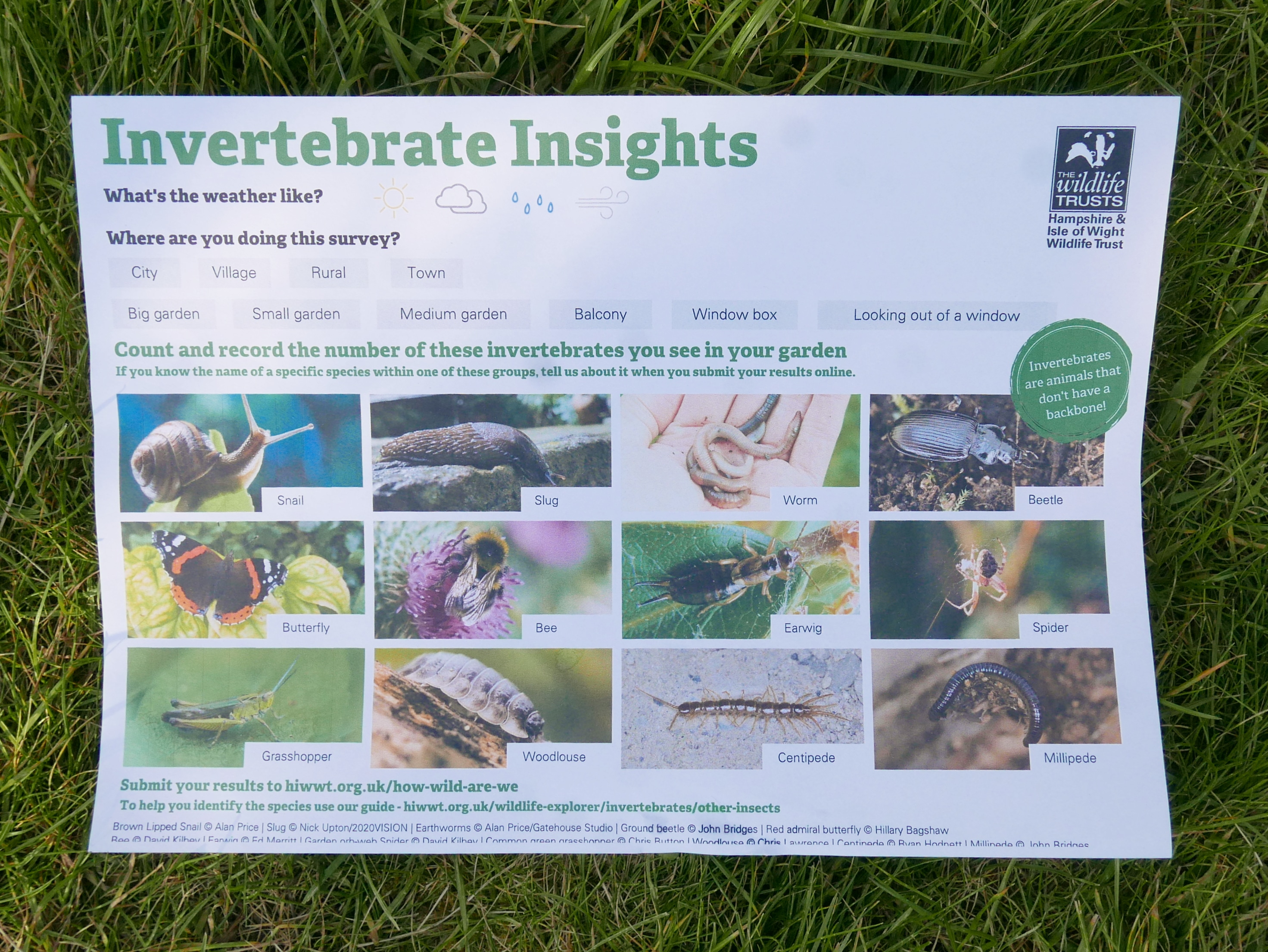
12. Create natural habitats for insects and minibeasts
As wildlife habitats are in decline it’s more important than ever to make space for wildlife in our gardens or around our homes. One of the simplest things you can do is let areas of grass grow long and wild in your garden. Long grass provides shelter and food to a whole host of wildlife. We’ve already found that leaving areas of long uncut grass growing in the garden has massively increased the variety and amount of insects and wildlife we find. May in particular is an important time to leave the lawn to grow and flourish as this is often when any wild flower plants that have been hiding in the grass begin to flourish and flower.

Insects and amphibians will enjoy the cool shade and moisture the long grass retains, and any wildflowers that flourish amongst uncut grass will bring an increased numbers of bees, beetles and butterflies. Birds and small mammals will also feed on the grass seed and hedgehogs, bats and predators like owls, frogs and foxes will all benefit from the increased number and diversity of mini beasts. How about leaving a border of long grass all around the edges of your garden to provide a safe corridor for wildlife to move through. You could even sow wildflower meadow mix into the grass or even plant mini meadows in pots or a window boxes.
Did you know that a third of the food we eat comes from plants that rely on pollination? Even medicines and materials like morphine, aspirin and cotton are derived from pollinated plants? Yet pollinator species across the world are in drastic decline due to widespread pesticide use and the loss of habitats.
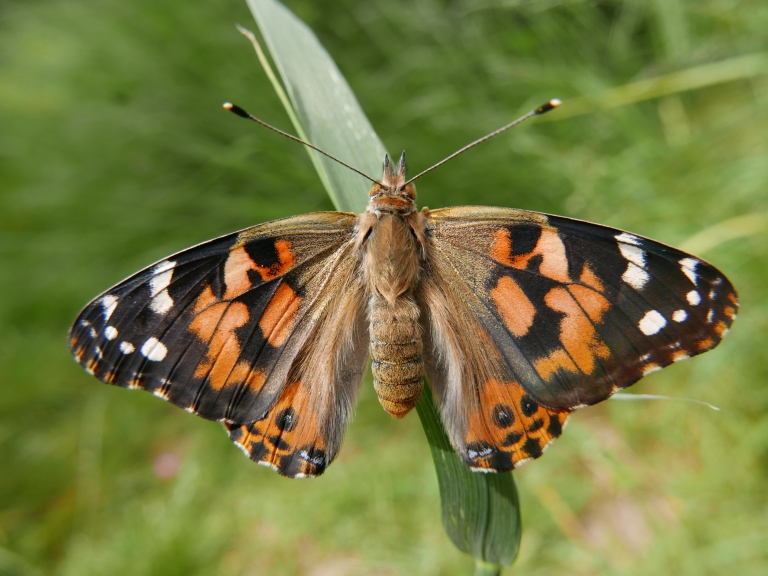
This is why its so important to help pollinators like bees, butterflies, moths, hover flies and beetles by providing food and egg laying spaces for them. You can easily do this by growing as many wildflowers and pollinator friendly plants and flowers as you can, thereby provide a source of food for all year round as well as giving them the plants they need to lay their eggs on.
You can find a handy list of plants that provide a source of food for butterfly caterpillars here. And a list of nectar rich plants and flowers that butterflies can to feed on here. And a list of nectar rich night scented plants and flowers that Moths can feed on here. And a list of nectar rich plants and flowers that Moths can feed on here.

13. Use a Pollination garden shop calculator
The Buzz Club have created a wonderful and simple to use calculator that shows you how much the food you grow replies pollinating insects like bees, butterflies, moths, hoverflies and beetles. To use the Garden shop calculator you just need to download a simple spreadsheet here and fill in the amounts of the food you have grown in your garden, window box, plat pots or allotment. The spreadsheet will then calculate the total value of the harvest if you had to buy it from the shop and what % of the harvest is directly contributed to by bees and other pollinating insects. Alternatively you can also use it to calculate what percentage pollinating insects like bees have contributed to growing any food you have picked from a farm or bought in a shop.

If you live in the UK you can also feedback your results to help with a citizen science project. To feedback your results simply fill in and submit the results using the sheet provided on the buzz club Garden shop calculator page here.
14. Let the ‘weeds’ grow wild
It’s a shame that so many important wildflowers and plants are considered unwanted “weeds” that are often pulled up or killed off by chemicals. Dandelions are beautiful wildflowers that provide an important source of food for pollinators. They flower early in the year long before any other plants. Bees, butterflies, and many other insects feed on the pollen and nectar, and caterpillars of butterflies and moths feed on the plants. Some species of bird even feed on the seeds. The entire plant is also edible for humans, you can eat the leaves, stems, flowers, and roots of dandelions.

Stinging nettles also provide an important source of food for wildlife. The caterpillars of several species of butterfly and moth rely on the plants for food, ladybirds lay their eggs on the leaves, bees and other pollinators feed on the nectar from the flowers and some species of bird even feed on the seeds. Humans throughout history have also relied on nettles for food, clothing, dye and rope.

Ivy is also a vital source of food late in the year for many pollinators long after the last flower has bloomed. Over 140 species of insect and 17 species of bird feed on ivy pollen, nectar, plants and seeds, many other species also use it for shelter. Resist the urge to cut back Ivy in the autumn or winter as this is when it flowers.
15. Make an insect shelter
Creating shelters for insects is a great way to increase the diversity of wildlife in your garden. Many insects benefit from having shelter and a healthy population of insects will also provide a ready source of food for other wildlife such as hedgehogs, frogs, toads, slow worms, bats and birds. They can be made using just recycled and found natural materials and you don’t have the room or a garden for a big insect shelter you could always make a mini one to place in a window box or hang from a wall or fence.
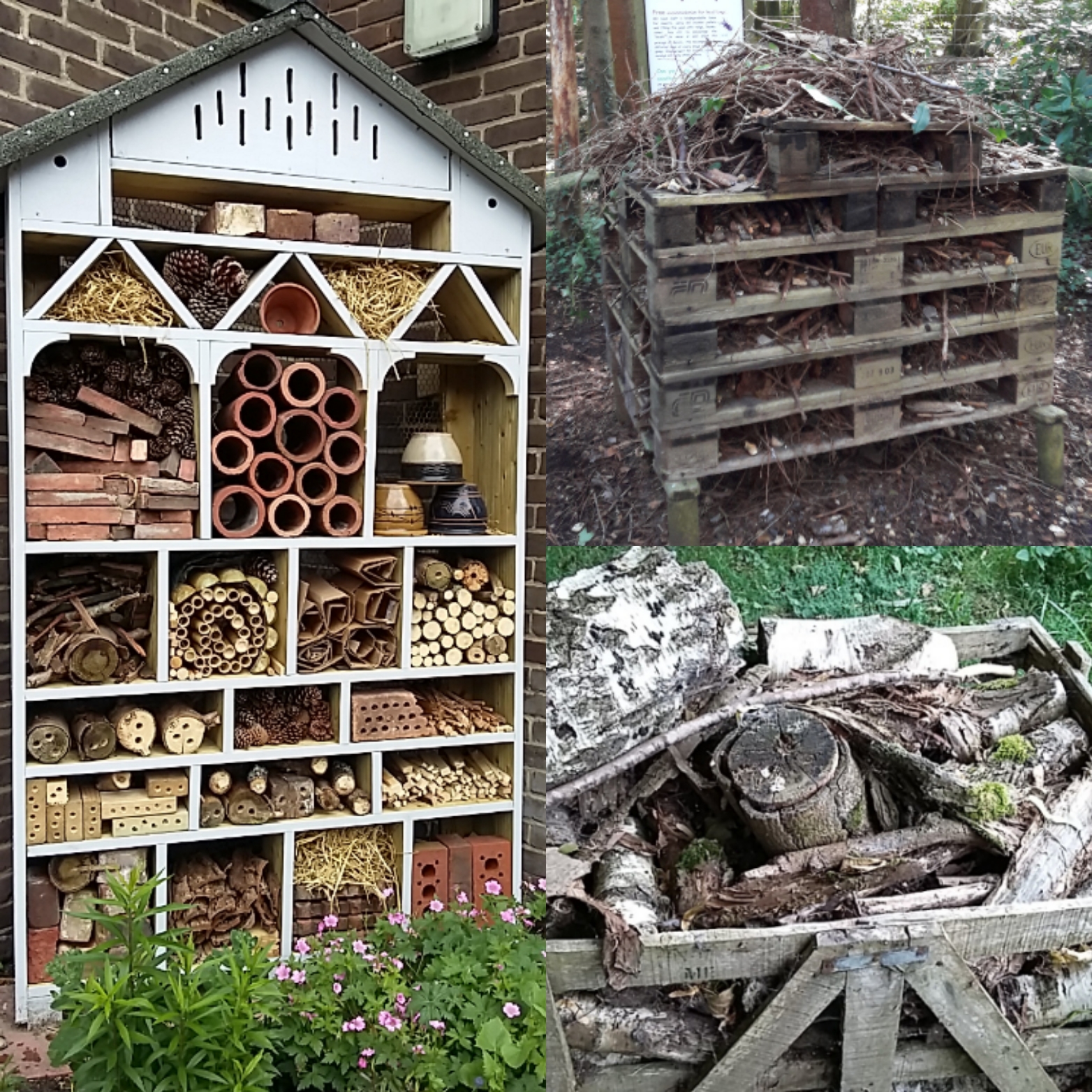
An insect shelter can be as simple as a pile of logs or a plant pot full of sticks or as grand as a multi layered bug hotel. Collecting the materials to make an insect shelter is an enjoyable activity in itself. How about looking around in the garden or on a nature walk to find materials you need to use.
Hollow bamboo canes, small clusters of tubing, bricks with holes in and wood with natural or drilled holes are all brilliant materials that create nesting sites for solitary bees. Unlike Honey bees solitary bees do not live in hives. As the name suggests they mostly live alone making solitary little nests in the ground or holes in walls and trees.

Old wood like logs, branches, planks, wood, pallets, crates and sticks create the perfect conditions as they rot down for insects that like damp, dark places, like ground beetles, woodlice, centipedes and earwigs. Just make sure any wood you use is paint free and doesn’t have any loose or sharp nails or staples sticking out. Layered rocks, stones, pebbles, bricks, paving slabs and plant pots close to the ground all help create cool shady nooks and hiding places for creatures like frogs, toads, slow worms, lizards, snakes and spiders.
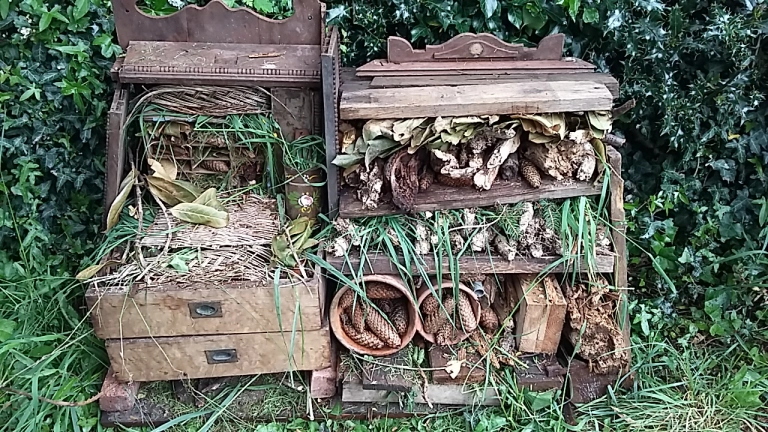
You can pack plant pots and the larger spaces in your insect house with other smaller natural materials like pine cones, cut grass, leaves, old dried ivy stem clusters, straw, hay, moss, twigs, old bunches of flowers and a sprinkling of loose earth to encourage the smaller insects. Remember to leave lots of spaces and gaps at the bottom for larger wildlife to hide in and under.
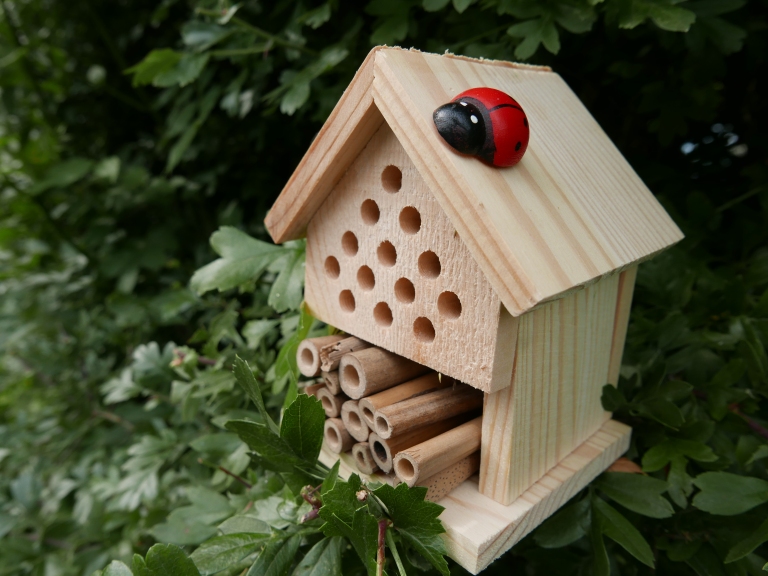
To make a smaller insect house that you can place on a window box, wall, fence or hang from a tree you will need an old tin, mug or a flower pot. You can have fun decorating the outside with paint and pens on the outside and then fill them with natural materials like sticks, pine cones, cut grass, leaves, moss and hollow bamboo canes. There are also many commercial varieties you can buy as well if you prefer which you can also have fun painting and decorating.
16. Make a wildlife pond
Ponds are important source of food, water and shelter for many animals and insects. From amphibians like frogs and newts, to aquatic mini beasts and insects like dragon flies (which begun their lives as underwater nymphs) and bats and birds that eat some of the insects. Making a small wildlife pond is very simple, all you need is a watertight container (or waterproof sheeting). Pond plants, rain water, soil, stones rubble and bricks.

Safety note: Open water of any kind can present a drowning risk for small children and pets. Please make sure your pond is secured in some way (with netting or barriers) so children and pets are prevented from accessing the water.
The first thing you need to do is dig a hole big enough to fit your container in. You then need to put a base of soil into the container to provide nutrients for the pond plants to grow in, and somewhere for water insects to burrow.
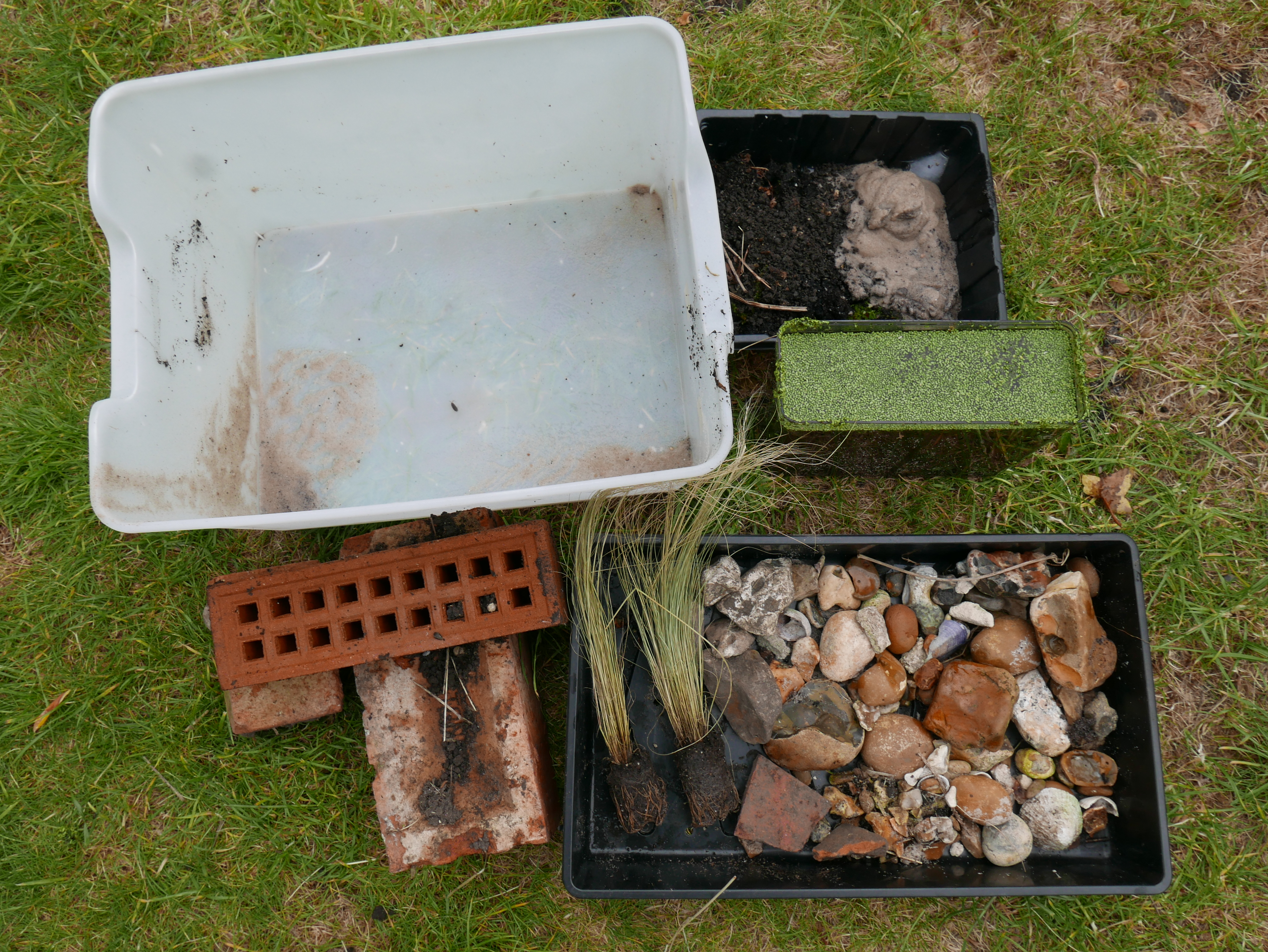
Next you need to make sure there is a basic staircase at one end to create an easy escape route for any wildlife that may fall in the pond. (To prevent accidental drowning). You could also add in some rubble, stones and old small terracotta plant pots to provide hiding places for aquatic minibeasts.

Now you can fill the pond with rain water or water from a natural local source (that you can safely collect in buckets ) It’s best use natural water as it won’t contain any of the fluoride or other chemicals may be present in tap water.

The final and most important thing to put in your pond are aquatic plants that will create oxygen in the water and provide a source of food and shelter for pond creatures and insects. We used duck weed as our tadpoles love it and it creates a nice cover over the pond to give them lots of shelter.

Another way to provide shelter is to layer piles of rocks, stones, pebbles, bricks, paving slabs and plant pots close to the edge of the pond to help create cool shady nooks and hiding places for amphibians and other wildlife to shelter in and hide from predators. You could also plant wild flowers and flowering shrubs round the pond to encourage pollinating insects and provide additional shelter for wildlife. Now you can leave your pond to flourish and grow. Just keep an eye on it throughout the seasons to see what wildlife has moved in or is stopping by to visit your pond.
- For day 20 of 30 Days wild we celebrated National Insect week by taking part in the Bugs matter survey, looked for insects in the garden and used the Buzz clubs pollination calculator to calculate how many pollinators had helped grow all the fruit and veg in our garden.
If you like this you might like to try:
Exploring trees and woods 30+ activity ideas

Exploring the shore 20 activity ideas

20 ways to make a home for wildlife


11 thoughts on “100+ insect and minibeast activity ideas”